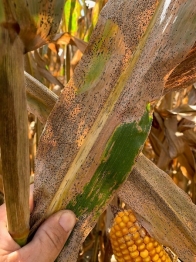WESTFIELD, Ind. (June 6, 2024) – When wet weather slows planting, it’s easy for farmers to doubt the potential of their crops, says AgriGold Agronomist Josh Johnston. “I want them to take comfort knowing they can still grow really good corn and soybeans.”
“If we lose yield by planting late, we can gain it back by slowing the corn crop down in the fall,” Johnston says. “August tends to bring some cooler nights, and corn loves finishing in that.”
The season and your management strategy will dictate how crops turn out.
Soils are less forgiving with late-planted crops
Farmers working to manage the workload of a growing season on a condensed time frame should think critically about what they can push and what they can’t. Planting and working ground are two areas that shouldn’t be rushed, according to Johnston. “Mistakes with either of these will have season-long ramifications.”
Soils typically stay moist and are, therefore, more forgiving of mistakes in March and April. “There’s more heat intensity later in the season, so a horizontal layer will turn into concrete that roots can’t penetrate,” Johnston says. “Unless it rains often, you’ll face trouble.”
Also, keep in mind it takes fewer growing degree units (GDUs) to reach black layer with later-planted crops. “Corn requires 6.8 fewer GDUs to reach black layer each day planting goes past May 1, according to Purdue University,” Johnston says. “That’s important to know when calculating if it’s too late to plant/replant.”
Dial back corn and scale up soybean populations
For those still waiting to get seed in the ground, Johnston’s No. 1 recommendation for corn is to reduce the seeding population by 1,500 to 2,000 plants per acre.
“We typically have more heat with late planting, so we usually get a good stand,” he says. “Plus, lowering your plant population will help alleviate some of that stress during critical time frames like pollination when heat and drought are more likely.”
He recommends the opposite for soybeans. The reason for that goes back to the differences between corn and soybeans. Corn is a day-neutral plant that’s solely driven by heat. Soybeans, on the other hand, are short-day plants. “As the day length shortens, they’re triggered to go into reproduction,” Johnston explains.
He advises increasing soybean planting populations and modifying maturities to keep soybeans in the vegetative stages deeper into the season.
Be vigilant and proactive when it comes to threats
Late planting comes with an elevated risk of insect or disease injury. “The No. 1 line of defense for both threats is heavy crop monitoring,” Johnston says.
His primary concern for northern farmers is tar spot. In recent years, the crop has been more mature when the disease ramped up, limiting the toll. But later planting dates for some areas paired with more conducive conditions for the disease could result in a harder hit this season.

Johnston’s main concern for farmers in southern areas of the country is southern rust. “Exposure to the disease will likely be longer than normal due to the planting delays.”
Pests could also cause more damage to late-seeded crops — namely corn earworm pressure in the South and corn rootworm to the north. Last season, Johnston says Kentucky faced “extremely high levels of earworm.” Because this spring has been a “carbon copy” of last year, he’s bracing for another major battle with the pest.
Corn rootworm is a major concern for northern areas of the Corn Belt. Those regions are running a few GDUs ahead of the norm, which could result in earlier hatching of corn rootworm, Johnston warns. “Pair that with younger corn with a smaller root system, and those larvae could cause a lot of trouble.”
Farmers need to be proactive with their fungicide program and any insecticide applications. “Make applications before you see pressure in the fields for better control,” Johnston advises.
He also encourages farmers to stay the course with their fertility plans. With late planting, it can be tempting to rein in fertility to save money. “If you create a nutrient deficiency by pulling back some of your fertility, and then you add in the likelihood of increased environmental stress, you’re putting yourself in a losing situation,” Johnston says.
Harvest considerations
Later-planted corn is always taller, making it more vulnerable to greensnap and storm damage. “Farmers should consider what they can do to limit those risks, such as adjusting their row direction,” Johnston says.
Those with late-planted corn should also plan on drying more corn. “Once we get into November, it’s virtually impossible to naturally drive moisture out of the crop,” Johnston says.
Want more support navigating this season’s challenges? Reach out to your local AgriGold agronomist.
Main image: Scouting fields for pests like corn earworm (pictured) is especially critical in years when crops are planted late.


